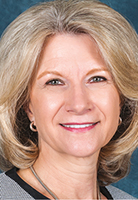
President's Corner
Loving Diversity in Public Education
By Gail Pletnick/
School Administrator, November 2017
 IN JULY, I HAD
IN JULY, I HAD the privilege of attending the Canadian Association of School System Administrators conference in Halifax, Nova Scotia. The theme was Healthy Schools, Healthy Communities, Healthy Future and, as expected, presenters addressed such topics as suicide prevention and how to embed wellness goals into strategic plans.
One topic in particular that resonated with me was the importance of respecting every child regardless of his or her native language, ethnicity, race, socioeconomic status, place of residence or any other factor used to label and sort students in our schools.
Several CASSA conference sessions shared school-based programs that honor students’ heritage and acknowledge the contributions and struggles of ethnic groups. They spoke to me of building in each child a sense of pride in his or her heritage and encouraging and celebrating all people coming together to build a stronger community and country.
In fact, the conference opened with a program about the power of words, and I was taken by the use of the term First Nations in referring to Native American tribes living in Canada. How respectful to acknowledge these indigenous people living in Canada as the First Nation!
In our schools, working to build an understanding and appreciation of others, then celebrating the gifts and contributions each of us brings to our community of learners is a formula for success. We need to celebrate the diversity we have in our schools and celebrate the understanding that relationships and respect are critical to appreciating the uniqueness and the commonalities our students represent in our diverse school populations.
That appreciation for and desire to be inclusive applies not only to students within a learning community, but also to the workforce within our schools. A 2016 report by the U.S. Department of Education, “The State of Racial Diversity in the Educator Workforce” cited statistics from the most recent federal Schools and Staffing Survey showing 82 percent of public school teachers identified as white. That figure has changed little in more than 15 years. Data from a similar survey conducted by the Department of Education in 2000 indicated 84 percent of teachers identified as white.
Those interesting statistics remind us that when we speak of the positive influence diversity can have in our schools, we must ensure our teachers and administrators represent the diversity we see in our student population.
Love Public Education
AASA has launched an
I Love Public Education campaign. We need this campaign to applaud the work in our public schools to embrace diversity regardless of whether we are defining it as racial diversity, socioeconomic background, gender, sexual orientation, disability status, religion or any other classification used to identify students or staff.
Our public schools offer many examples of leadership focused on embracing diversity and addressing issues of equity. The North Clackamas School District in Milwaukie, Ore., led by AASA’s 2017 National Superintendent of the Year Matt Utterback, adopted a district equity policy and developed a strategic plan that captures the district’s focus on celebrating diversity in North Clackamas and closing any gaps that challenge the success of each student. We can state I Love Public Education because we have dedicated leaders like Utterback who not only lead the way in addressing equity, but also share their good work with other districts so they may benefit.
We need to shine the spotlight on our school leaders who are redefining, redesigning and re-imagining schools to celebrate diversity and address matters of equity. Share your good news about diversity, equity and innovation in your public school at
#ILovePublicEducation.
Gail Pletnick is AASA president in 2017-18. E-mail:
gail.pletnick@dysart.org. Twitter:
@GPletnickDysart